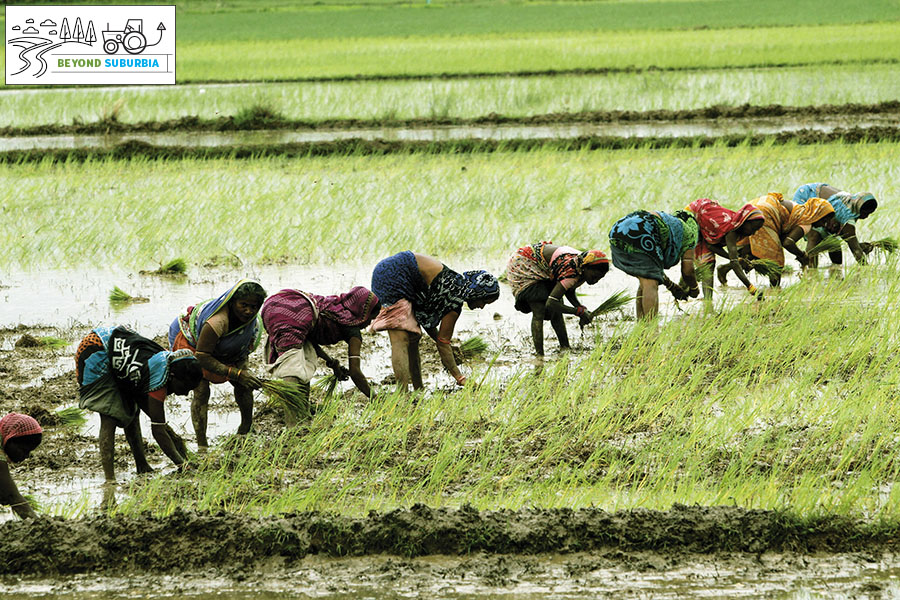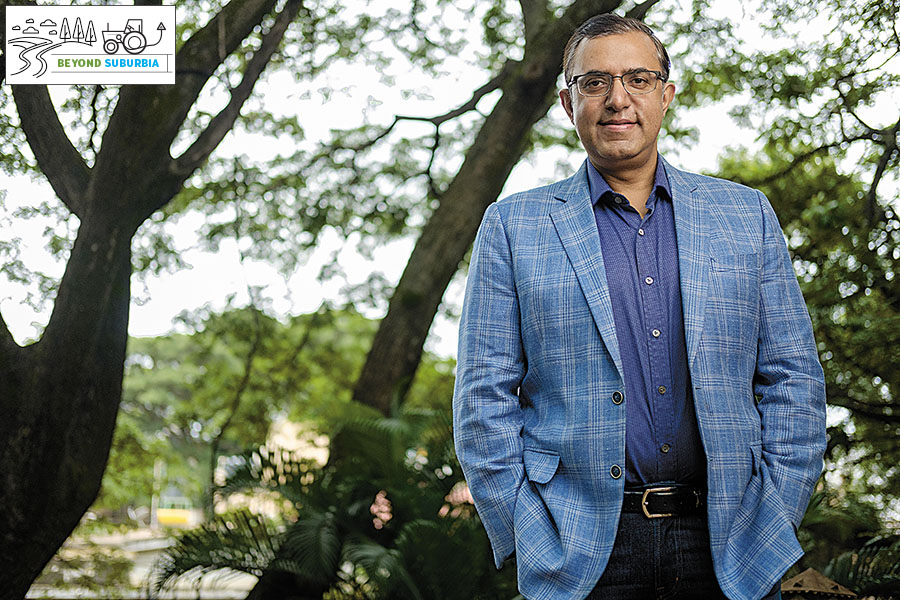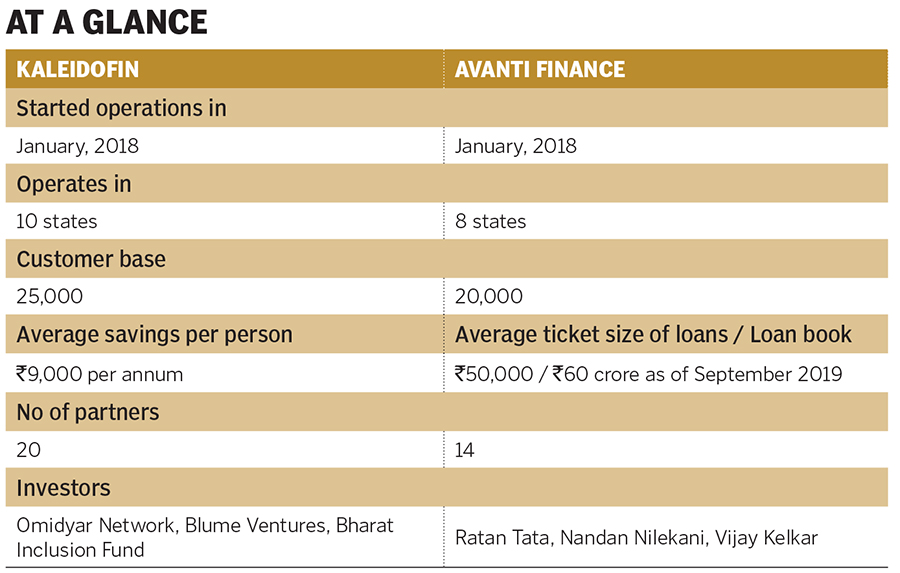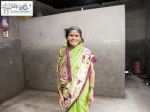
Credit where due: Startups solving the rural banking problem
Despite the strides made by Jan Dhan Yojana, last mile connectivity continues to pose a problem for rural banking; new ventures are trying to solve that by leveraging technology and partnerships
 A significant number of beneficiaries of rural MFIs turn out to be women, who form a large part of the agrarian workforce
A significant number of beneficiaries of rural MFIs turn out to be women, who form a large part of the agrarian workforceImage: Biswaranjan Rout/ Nurphoto via Getty Images
Tall, slender and all of 26, Vennila Ganesan emerges from her concrete hut, two toddlers in tow. Behind her, a row of similar, white-walled huts stretch into the distance. Goats graze nearby; a stray dog follows them about. Here in Kanurpudur, a village km north of Coimbatore, the sun shimmers but a crisp breeze is in the air. Ganesan, dressed in a pink, printed nighty with a dupatta neatly pinned on either shoulder, has just returned from a day in the sugarcane fields nearby, pocketing ₹250 for the day. She took a loan of ₹25,000 from Samasta, a micro finance institution (MFI) with outposts in the area, about two years ago, and bought eight baby goats. Later this year she plans to sell the goats at a ₹20,000 profit. “It will help me take care of my children,” she says. “Especially in the [summer] months when there is no agricultural work.” Asked if she uses her bank account regularly, she lifts her hand to her mouth to hide a giggle and shakes her head in denial. “I opened it years ago to get the government subsidy for the birth of my first child,” she says. Since then she has only used it when necessary; when she had to access Samasta’s monies that were credited to her account. Or to take care of the monthly interest payments that are directly debited from her account, in which case she makes the three-hour long trek to the closest bank branch—compromising on a day’s wages—to deposit just enough money. Ganesan’s ordeal is not uncommon. The Jan Dhan Yojana scheme, launched by Prime Minister Narendra Modi in 2014, aimed to provide every Indian household with a bank account by 2018. The account-opening spree saw adults with bank accounts jump from 53 percent in 2014 to 80 percent in 2017, according to the World Bank. But that hasn’t translated into meaningful financial inclusion, especially for rural, low-income populations. Bank branches are long distances away, form-filling is tedious because of low levels of literacy and distrust of financial institutions runs deep. Besides, most low-income families transact in cash and prefer to store their savings where it’s easily accessible. In a country so vast it’s difficult to build the physical infrastructure—brick-and-mortar bank branches, ATMs and banking correspondents—to service rural, low-income families. “India has made a lot of progress in the past two decades but there is more work to be done,” says Gregory Chen, lead financial sector specialist at the Consultative Group to Assist the Poor (CGAP), a think-tank housed at the World Bank. He points out how the country has moved past its over-reliance on a few state-owned banks to a more diverse, private sector driven financial system. This includes the opening up of small finance banks as also payments banks that let customers make deposits, transfer money, and pay utility bills through outposts at local kirana stores. But these are yet to penetrate rural India, in places like Ganesan’s village. Moreover, innovations in digital payments that run on UPI, the interbank money transfer system launched by the government in 2016, have led to a spurt in the number of payments providers. But in the absence of sufficient cash-in and cash-out points in the hinterland, people will not shift to digital money, says Chen. Consequently, platforms are finding ways to offer meaningful financial inclusion to the rural poor without building more bank branches. Instead they’re leveraging technology and a network of existing partners to provide services like savings, investments, credit and insurance to people like Ganesan.
 Sucharita Mukherjee (left), Kaleidofin: Providing tailored financial solutions for customers
Sucharita Mukherjee (left), Kaleidofin: Providing tailored financial solutions for customersImage: P Ravikumar for Forbes India
“People should have access to wealth management services regardless of their income level,” says Sucharita Mukherjee, co-founder and CEO of Kaleidofin. The Chennai-based company was founded—around two years ago—on the premise that people don’t “go around shopping for financial products” as Mukherjee puts it. Instead they have goals, like saving for a child’s education or buying a two-wheeler, and look for solutions that help them achieve those goals. Kaleidofin, for example, reached out to Ganesan through Samasta and found that she was looking to save money so that her two children aged five and three could get the kind of schooling that she never got. After discussing her goals with her, the data was inputted into Kaleidofin’s app; an inbuilt algorithm analysed her risk profile taking into consideration factors such as family income, occupation, skill sets and the probability of natural disasters in her geographic area, along with credit bureau and savings account information, if available. It calculated that she needed to save a minimum of `500 a month for three years. “It’s a tailored solution,” says Mukherjee, who previously headed IFMR Holdings, a Chennai-based company she helped set up with Kaleidofin’s co-founder Puneet Gupta to invest in and operate financial services companies that serve rural areas and informal sectors. Ganesan enrolled herself on Kaleidofin—an app-based process that takes minutes to complete with the help of an agent—a couple of months ago but she is yet to start saving money. “I want to save,” she says. “But I rarely have any surplus left after meeting our family expenses.” “We engage in regular discussions with customers like Ganesan to encourage them to save. We tell them to put aside ₹15 to ₹20 a day so that by the end of the month they have ₹500 to save,” says R Babu, a senior cluster manager for Kaleidofin in Coimbatore. It comes with its perks. Those savings, directly debited from a customer’s bank account every month, are invested in tailored plans based on the customer’s profile. For instance, Lakshya is a plan for regular investments in a debt fund for customers who can’t take on risk. The Udaan plan is for households with surplus income who can take risks; 20 to 40 percent of their monies are invested in equities. Umeed is for those who have volatile incomes, like Ganesan, who can invest only meager amounts; the key is to inculcate in them the discipline of saving. There’s also a plan for newly-weds to save for a baby. Besides, all the plans come with a ‘skip option’ in case customers can’t save money that particular month, insurance for the saved amount, and a line of credit for meeting urgent needs like medical emergencies. Kaleidofin has been operating for a year and a half and has already amassed 25,000 customers across 10 states, including Rajasthan, Bihar, Tamil Nadu, Gujarat and, most recently, Maharashtra. The company charges customers ₹20 a month in advisory fees and takes a commission from its financial partners (mutual funds, insurance companies) for deploying their products. It’s raised around ₹20 crore from the Omidyar Network, Blume Ventures and the Bharat Inclusion Fund. “Key to their scale up has been their partnerships with MFIs and NGOs who work on the ground,” says Karthik Reddy, Blume’s co-founder and managing partner. “The partners help them access potential customers and manage operations,” he says. Similarly, Avanti Finance is drawing on partnerships to solve a “population-scale issue in a population-scale manner,” says CEO Rahul Gupta. Set up in mid-2016 with philanthropic capital from Ratan Tata, Nandan Nilekani and Vijay Kelkar, the for-profit entity provides loans to high-risk borrowers.
 Rahul Gupta, Avanti Finance: Solving a “population-scale issue in a population-scale manner”
Rahul Gupta, Avanti Finance: Solving a “population-scale issue in a population-scale manner”“Seventy percent of our borrowers are first-time borrowers,” says Gupta referring to the 22,000 customers they have serviced across eight states and 25 districts since starting operations a year ago. So how is Avanti different from a regular MFI? For one, Avanti offers a tech-based solution that is frictionless and fast. Data entered into Avanti’s app takes 12 minutes to process and monies are credited to the borrower within two days, says Gupta. Second, unlike the “hard touch” MFI model where an agent goes around collecting interest payments, Avanti collects cash digitally [interest rates are 18 to 20 percent with no late payment charges]; many use the Bhim app to pay their dues. This keeps costs low, allows for transparency and ensures scalability. Third and, importantly, Avanti leverages the deep community knowledge of its NGO partners to assess and service borrowers. “All institutions look at a borrowers’ intent and ability to pay. So do we, but we rely on our partners to do it in a hyperlocal, nuanced way. This helps us customise products for the community,” says Sunil Kumar Tadepalli, Avanti’s head of partnerships. For example, a loan that Avanti extends to villagers in Jharkhand looking to purchase the Bengal Buck, a goat local to the area, is different from one to a Rajasthani villager buying the native Sirohi goat. Says Tadepalli, “You can say a goat is a goat is a goat and standardise the loan but that doesn’t help. The dynamics, cash flow and market for different breeds of goat vary. Our partners help us understand this.”

The reliance on partners also allows Avanti, which will have a loan book of ₹60 crore by September, a higher appetite for risk. Take the case of Assefa in Tamil Nadu, set up five decades ago to transform wastelands into cultivable ones for poor farmers. Today, the NGO runs health care, women empowerment, livestock rearing and agriculture-based programmes in villages across India, and also has a network of 2,500 Google-trained ‘Internet saathis’ promoting digital literacy. These women double as agents for Avanti, helping them identify borrowers, monitor them and feed that information back to Avanti. “Credit is a powerful tool for social change,” says Assefa’s affable, 82-year-old founder Annachi Loganathan. “Avanti is helping bring about that change by providing affordable, accessible loans.” Eventually Avanti plans to open-source its platform so that all institutions, including the government, can use it to bring unbanked and under-banked individuals into the financial fold. Says Gupta, “Mr Tata always says, ‘Our only competition is poverty’.”
(This story appears in the 27 September, 2019 issue of Forbes India. To visit our Archives, click here.)
Post Your Comment


















